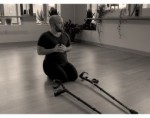
Writing to Move, Moving to Write
by Kristen Shahverdian
Have you experienced that moment, sitting at your desk and no longer able to read or write, when you get up to move around, eat a snack, or stretch your arms overhead? The walk to the refrigerator might refresh you, and you could then return to the task at hand. Cheryl Pallant, in her preface to Writing and the Body in Motion: Awakening Voice through Somatic Practice, describes having one of these moments in graduate school. Her curiosity about the relationship between writing and movement led to a career as a writer, mover, and teacher. Writing and the Body in Motion draws from Pallant’s class, “Writing from the Body,” and serves as a passionate instructional manual for anyone interested in deepening their connection to writing and movement.
The format of each chapter is consistent; Pallant opens all seven with her musings, nuggets of research, and ends with a list of exercises. In the introduction, Pallant suggests the reader move sequentially through the book by reading the chapter’s contents before practicing the exercises. Alternately, the reader can skip the chapter’s explanations and go directly to the exercises, letting experience be the guide. These two ways of approaching the content exemplify Pallant’s argument throughout the book; that it is the weaving back and forth between moving and writing that matters here, neither above the other, and both needing each other to blossom.
The first chapter, “The Subjective Body,” covers the field of somatics, developed by Thomas Hanna. As Pallant discusses the importance of embodiment, she also cues corresponding exercises that deepen one’s understanding of their physical experience. In one, I am instructed to define my body in words. After writing, I am invited to touch my body and walk through space, and then revisit my definition. Does placing my hands on my belly change my feelings about my body? Does walking through space change my definition of my body? The internal feeling state of somatics examines personal experience and individualism. Pallant challenges individualism in a later chapter, “Evolutionary Body,” and offers bodily experiences exploring interconnectedness and collectivity as a vision for the future of the field.
I feel contemplative, in a state of peaceful curiosity, while reading the initial chapters. In “The Kinesthetic Body,” Pallant writes, “The more in touch we are with the many layers of our body, the more in touch we are with our balance, our voice, our motion, our gifts and the awe of being alive… Movement is how we engage with the universe of our body.”(p.65) Her words resonate with beauty and positivity towards the body, writing, and movement.
Pallant decouples the hierarchy of writing over movement and posits them as equals. She notes, “Writing furthers the understanding, expression, awareness of the somatic body which, in turn, furthers the expressive capability of writing.” (p.95) Our writing can help us make sense of the body, and vice versa. Pallant develops a persuasive argument that writing needs the body and the body needs writing. She continually returns to the sequence: move, write, move, write (one could also start with writing). The writing, like the movement, is steeped in somatics. This mode of writing emphasizes sensing the words in our body and feeling the reverberations words create inside of ourselves.
The positivity, peace, and joy in Pallant’s words congeal into a somatic wonderland. I am delighted by it, yet I find it hard to distinguish between chapters; there are only a few examples to ground the theoretical concepts. Some of these examples are stories: Hal, the baseball player whose chest is pressing in on himself, becomes aware of his breath and then informs his parents that he has trouble breathing. This awareness saves his life; no small thing, but accounts like this are brief throughout the book. I wanted more of these concrete examples to see how the theory becomes a practice.
Pallant includes black and white photographs throughout: a student writing on a bench, an arm resting on the ground, an open journal. I understand that these are images of students practicing the work, and I acknowledge the challenge of showing bodies in deep exploration or of publishing students’ private thoughts. However, the images do not illustrate the churning of processes. The subtitle of the book, Awakening our Voice through Somatic Practice, has me wondering how the practice becomes public. What channels movement and writing into voice? One image captures an exercise at work. In “The Imagining Body,” a photograph shows movers standing above their shadows, leaning their torsos and reaching their arms towards their shadow-selves. The caption reads, “integrating the shadow,” and in both word and image I can imagine the practice of moving with my shadow.
Writing and the Body in Motion is a book one can return to often. There are many exercises that can and should be repeated; with each reiteration, one’s relationship with the body and writing may change. Pallant concludes her discussion with an introduction to social somatics- a field of somatics that recognizes that our bodies are social, that we move with culture, with gender, with privilege or without it.* This section is not long but is filled with names in the field that readers can research on their own and answers the question, why does somatic practice matter for our world? As Pallant states, “to listen and attend to the voices of another is to listen and attend to oneself.” (p.141) Building empathy and understanding among people is a process you can begin in your body.
*See Emma Cohen’s article Embodying Anti-Racism about somatics and anti-racism.
Cheryl Pallant, Writing and the Body in Motion: Awakening Voice through Somatic Practice. Jefferson, North Carolina: McFarland & Company, Inc., Publishers, 2018. 188pp.
By Kristen Shahverdian
August 7, 2020










